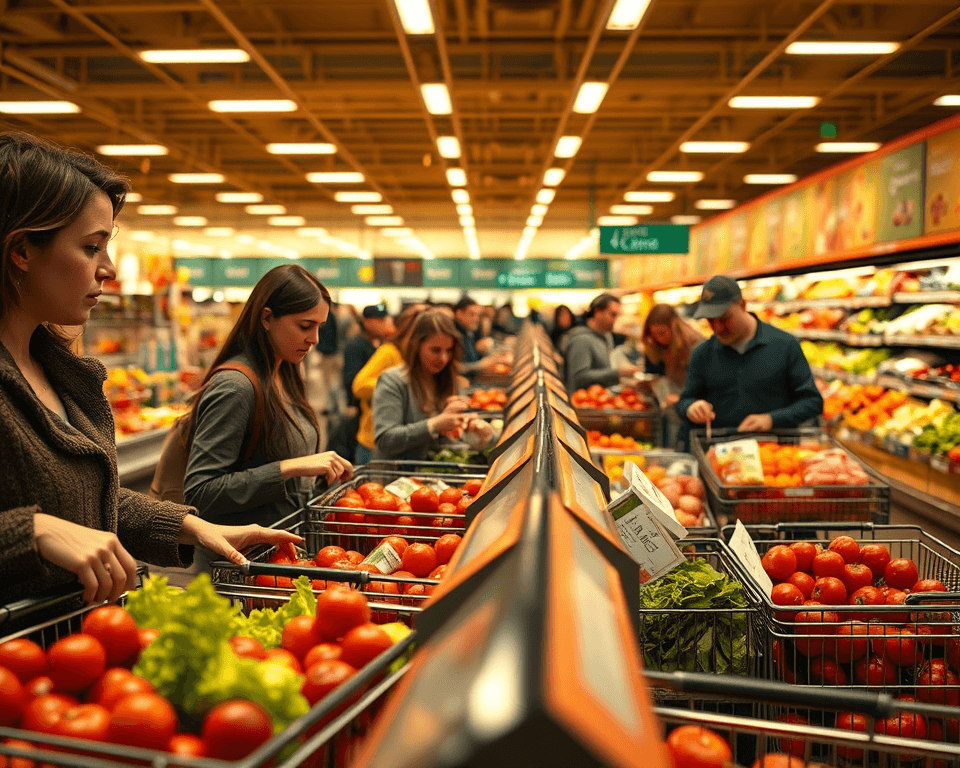Ah, the thrill of shopping! You walk into a store with a cart and excitement, but you have to face those notoriously long checkout lines. Sounds familiar? Honestly, who hasn’t felt that gnawing frustration as you watch the clock tick away while people fumble with coins or struggle to find their loyalty cards? Let me tell you: self-checkout systems are not just some fancy tech gimmick; they’re seriously revolutionizing our shopping experience! I mean, it’s about time we took control of our checkout processes, right? Let’s break down how self-checkouts make shopping more efficient, satisfying, and adaptable.
Key Takeaways
- Self-checkouts dramatically reduce waiting times and increase efficiency at retail locations.
- Customers enjoy a heightened sense of independence and privacy, leading to increased satisfaction.
- Retailers can see significant cost savings while maintaining high service quality through automation.
- Different demographics show varied comfort levels with self-checkouts, necessitating tailored implementations.
- Addressing security concerns can boost customer trust in self-checkout systems.
Increased Efficiency in the Checkout Process
Let’s kick things off with the sheer speed of it all—who doesn’t love a fast checkout? Self-checkout systems like the NCR FastLane or the Toshiba Self Checkout System are designed for lightning-fast transactions. Studies have shown that self-checkout can cut waiting times down significantly. In fact, a recent report indicated a 50% decrease in average wait times at retailers that implemented these systems.
Think about it: when you walk into a store and you see a long line for the cashiers, what do you do? Most of us will stomach the wait, but imagine strolling over to a self-checkout kiosk and beeping through your purchases in minutes. Boom! You’re out of the store quicker than your coffee can get cold.
How Self Checkouts Reduce Waiting Times
Long checkout lines can make shopping feel like a chore. I mean, whether you’re grabbing groceries at Walmart or quick items from Target, you don’t want to be stuck behind someone struggling with their coupons. People often feel frustrated by long wait times, but self-checkouts tackle this head-on. By streamlining the payment process, they enhance the customer journey, making shopping less of a hassle and more of a pleasure.
“With self-checkouts, I can spend more time enjoying my shopping experience and less time in line wasting my afternoon!”
Retailers implementing these kiosks have seen a significant increase in customer flow and satisfaction—keeping the lanes bustling and the customers happy.
| Retailer | Average Checkout Time (Traditional) | Average Checkout Time (Self-Checkout) |
|---|---|---|
| Walmart | 7 minutes | 3 minutes |
| Target | 6 minutes | 2 minutes |
| Kroger | 8 minutes | 4 minutes |
The numbers speak for themselves—self-checkouts are all about optimizing our time. It’s all about making the shopping experience smoother and more enjoyable.
Enhanced Customer Experience and Satisfaction
Let’s chat about how self-checkout systems are not just quick but are also improving the overall shopping experience. Ever been in a situation where you just want to grab a couple of items without the awkward chit-chat with a cashier? That’s where self-checkouts shine.
The Role of Independence in Shopping
Imagine being able to scan, bag, and pay for your items at your own pace. It feels empowering! I remember the first time I used one of those machines—I zipped right through the process, and it felt like I had complete control over my shopping destiny. No loud beeping from the cashier’s register, no awkward encounters. Just me, my items, and the satisfaction of knowing I didn’t have to battle a mountain of receipts.
Retailers have noticed this trend too. Many are now rolling out user-friendly interfaces designed to make self-service even easier. Feedback surveys post-implementation have shown a marked increase in shopper satisfaction, especially among younger customers who are more tech-savvy.
“I love doing self-checkout! I can keep my shopping private, get in and out, and carry my own bags.”
Additionally, this independence correlates with positive shopping experiences. Stores using self-service kiosks are reporting a boost in shopper happiness. The tactile and digital elements engage customers without the standard pressures that come with traditional checkout experiences.
Cost Savings for Retailers
Now, let’s talk about the financial side of things. Any smart retailer knows that keeping operational costs low is vital for the bottom line. Self-checkout systems allow stores to save on labor costs without sacrificing quality service.
How Retailers Benefit from Self-Service Systems
Consider companies like Kroger and Walmart, which have implemented self-service kiosks at scale. By reallocating labor from cashiers to customer support roles, they’ve maintained high service quality while effectively cutting costs.
Some reports suggest that retailers can see up to a 30% reduction in checkout labor costs after implementing self-checkouts. This allows them to allocate budgets to other essential areas, like sales promotions or enhancing in-store experiences.
Check this out:
| Cost Factors | Traditional Checkout | Self-Checkout |
|---|---|---|
| Labor Cost Per Hour | $12-$15 | $6-$8 |
| Average Checkout Staff | 3-4 | 1-2 |
| Checkout Delay Costs | High | Low |
With valuable savings like this, retailers can invest in technology upgrades that elevate the entire store experience. Meanwhile, shoppers feel the effects in the form of improved service speed and quality.
It’s a win-win situation: more money for the retailer and a snappier shopping experience for us.
Flexibility for Diverse Customer Preferences
Now, here’s something really cool: self-checkout systems cater to a whole range of preferences and shopping habits. Let’s be real; not everyone’s equally comfortable with technology.
Understanding the Varied Acceptance of Self-Checkout
Some folks zoom through self-checkouts without a second thought, while others are still figuring out how to scan items! It’s crucial for retailers to understand these differences and seek to make self-checkouts more inclusive. By offering tutorials or friendly support staff nearby, retailers can create an environment where everyone feels welcome.
Demographics play a huge role in how people experience self-checkouts. Younger generations typically embrace technology, while older shoppers may still prefer human interaction. Understanding these trends can mean the difference between a seamless experience and a frustrating one.
“I find self-checkouts super fast, but my mom still prefers talking to someone. It’d be nice if both options stayed!”
This insight drives retailers to adapt their approaches and design tech that’s flexible and accommodating; think touch screens that are easy to read and accessible options for those who may feel overwhelmed.
Addressing Security Concerns with Self-Checkouts
Okay, let’s hit a sensitive topic: security. A lot of people are wary of the self-checkout lane because they fear theft. And you know what? Those concerns are valid, but here’s the kicker: modern self-checkouts have some pretty robust security measures in place.
Building Customer Trust in Self-Service
Brands like IBM have integrated advanced technology like AI and cameras into their self-checkouts to prevent loss. This means every transaction is closely monitored, reinforcing the sense of safety for shoppers.
Additionally, providing clear information about how these systems work and how theft prevention is handled can help boost consumer trust. A reliable self-checkout system not only speeds up the payment process but also enhances security.
To sum it up, addressing these concerns upfront can make a significant difference. By ensuring that customers feel secure and supported, stores can create an environment that fosters loyalty and positive experiences.
“Knowing that my transaction is secured makes me feel way better about using self-checkouts next time!”
Let’s face it; nobody wants to feel like they’re being watched. But if customers understand that security measures are in place for their protection, they’re usually more willing to embrace the tech.
In this rapidly evolving shopping landscape, this balance between convenience and security can ultimately drive the acceptance of self-checkouts for years to come.
That’s a wrap on how self-checkout systems are enhancing our shopping experience, from speed to flexibility, and even security! If you haven’t tried it yet, I’d say jump in and give those machines a whirl! The future of shopping is right at your fingertips.
Frequently Asked Questions
What are the benefits of using self-checkouts in retail?
Self-checkouts enhance the shopping experience by increasing efficiency, reducing waiting times, and providing customers with greater autonomy during the checkout process. They can also lead to cost savings for retailers by decreasing labor expenses and optimizing operational efficiency.
Are self-checkouts secure for transactions?
Yes, many self-checkout systems incorporate advanced security measures, including fraud prevention technologies and monitoring systems to deter theft. Retailers continually work to improve transaction safety and bolster consumer trust in these systems.
How do self-checkouts impact customer satisfaction?
Self-checkouts generally improve customer satisfaction by offering a quicker, more convenient shopping experience. Shoppers often prefer the independence and privacy that self-service options provide, leading to positive feedback and enhanced overall experience.
What demographics are more likely to use self-checkouts?
Younger, tech-savvy consumers tend to embrace self-checkouts more readily than older generations. However, interest spans various demographics, and acceptance can vary based on comfort level with technology and previous shopping experiences.
Are there any disadvantages to self-checkouts?
While self-checkouts offer many advantages, they can result in user frustrations such as technical glitches and a lack of assistance when needed. Additionally, some shoppers may be concerned about security and theft in self-service environments.
How do retailers measure the success of self-checkouts?
Retailers evaluate the success of self-checkout systems through various metrics, including transaction speed, customer feedback, operational cost reductions, and the overall impact on sales and profit margins.
Can self-checkouts handle large transactions?
Self-checkouts are typically designed for quick transactions but can generally accommodate larger purchases. However, some larger retailers may designate specific self-checkout stations for high-value items to ensure sufficient customer support.
What technologies are used in self-checkout systems?
Modern self-checkout systems utilize various technologies, such as RFID scanning, touch-screen interfaces, and artificial intelligence for fraud detection. These advanced solutions aim to streamline the checkout process while enhancing customer security and engagement.
How can retailers improve the self-checkout experience?
To enhance the self-checkout experience, retailers can provide clear instructions, ensure system reliability, offer immediate support for users facing challenges, and continuously gather and act on shopper feedback to refine the process.
Do self-checkouts replace cashiers entirely?
While self-checkouts reduce the need for cashiers, they are not meant to fully replace them. Many retailers maintain a balance by keeping staff members available for customer support, managing complex transactions, and addressing potential security concerns.










